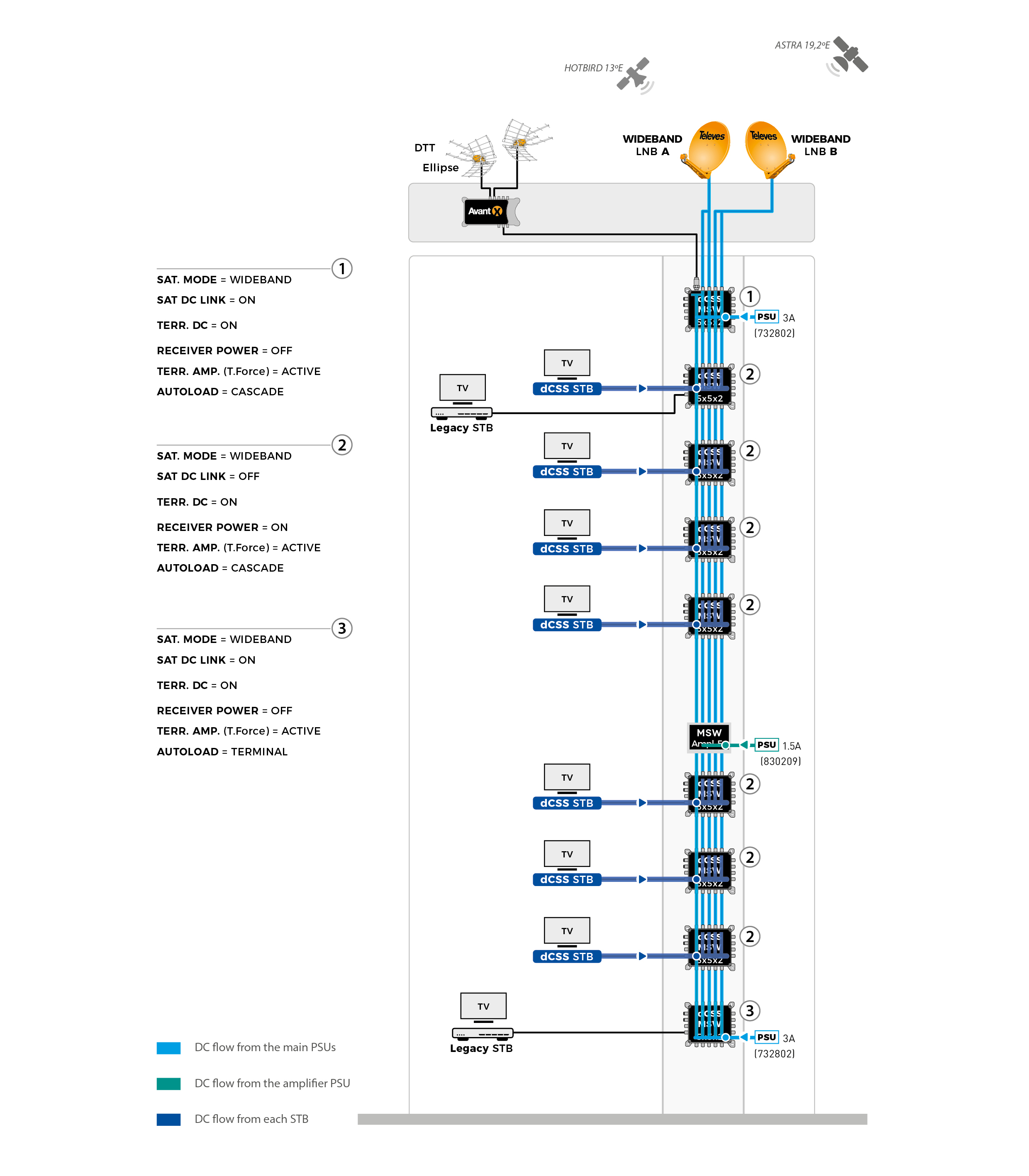EuroSwitch/NevoSwitch WideBand amplifier 10/13 dB, 5 inputs (2 satellites)
- Very compact
- High shielding (A class) thanks to its manufacture in Zamak
- High output level
- The TERR.DC switch isolates or connects the power supply available from the cascade in the terrestrial branch. Can be useful for the feeding of a mast amplifier or an intelligent antenna, but also for the terrestrial branches of other MSW in the cascade
- Gain and slope individual adjustment
- Wide voltage range: Voltages from 12 V to 18 V make it compatible with most existing systems
- Low power consumption
WideBand technology
WideBand (also known as FullBand) refers to broadband transmission technology that uses a wide range of frequencies. In WideBand TV systems, a substantial portion or the whole of the frequency spectrum is available to users. It can be used in fiber deployments where long cable runs are demanded, or coaxial scenarios in combination with multiswitches adapted to this technology.
In WideBand technology, an LNB captures a complete satellite signal and distributes it through 2 universal outputs (vertical -V- and horizontal -H-), each of them with the combination of high (H) and low (L) bands, in a frequency range between 290 and 2340 MHz.
Despite the fact that Quattro technology is the most widely deployed technology in TV systems nowadays, WideBand technology brings significant advantages to the installation:
- Simpler, faster and cleaner installation: In WideBand technology the number of coaxial cables connecting the LNB to the multiswitches is half as in traditional Quattro deployments, so the installation is done quicker and easier. The installation will also be tidier with fewer cables.
- Wider bandwidth than other technologies: WideBand channels can carry more information thanks to their wide bandwidth (290-2340MHz). This powerful feature allows a greater number of services to be delivered to the end users of the installation.
- Reusable deployment: WideBand technology allows signal distribution by reusing a Quattro installation. It can be distributed through the old 4 cables coming down from the roof to capture signals from up to 2 satellites, changing only LNBs and MSWs to be WideBand compatible.
| Number of inputs | 5 | |||
|---|---|---|---|---|
| Number of outputs | 5 | |||
| Bands |
| |||
| Frequency range | MHz |
| ||
| Output level | dBµV |
| ||
| Gain | dB |
| ||
| Gain adjustment range | dB | 0 ... 13 | ||
| Slope regulation | dB | 0 ... 12 | ||
| Isolation | dB | > 25 | ||
| Powering | Vdc | 12 ... 18 | ||
| Max current consumption (@12V) | mA | 270 | ||
| Max current consumption (@18V) | mA | 180 | ||
| Max. power consumption | W | 3.24 | ||
| Operating temperature | °C | -5 ... 45 | ||
| Protection index (IP) | 20 |
Physical data
Net weight: 364 g
Gross weight: 430 g
Width: 137 mm
Height: 121 mm
Depth: 29 mm
Main product weight: 356 g
Packing
Box 1 Units
| tlv_discontinued | No | |||||||||||||||||||||||||||||||||||||||||||||||||||||
|---|---|---|---|---|---|---|---|---|---|---|---|---|---|---|---|---|---|---|---|---|---|---|---|---|---|---|---|---|---|---|---|---|---|---|---|---|---|---|---|---|---|---|---|---|---|---|---|---|---|---|---|---|---|---|
| tlv_tags | WideBand technologyWideBand (also known as FullBand) refers to broadband transmission technology that uses a wide range of frequencies. In WideBand TV systems, a substantial portion or the whole of the frequency spectrum is available to users. It can be used in fiber deployments where long cable runs are demanded, or coaxial scenarios in combination with multiswitches adapted to this technology. In WideBand technology, an LNB captures a complete satellite signal and distributes it through 2 universal outputs (vertical -V- and horizontal -H-), each of them with the combination of high (H) and low (L) bands, in a frequency range between 290 and 2340 MHz. Despite the fact that Quattro technology is the most widely deployed technology in TV systems nowadays, WideBand technology brings significant advantages to the installation:
|
|||||||||||||||||||||||||||||||||||||||||||||||||||||
| tlv_reflog | VWBLG | |||||||||||||||||||||||||||||||||||||||||||||||||||||
| tlv_tabla_especificaciones |
|
|||||||||||||||||||||||||||||||||||||||||||||||||||||
| tlv_ean | 8424450270417 | |||||||||||||||||||||||||||||||||||||||||||||||||||||
| tlv_dim_product_x | 137 | |||||||||||||||||||||||||||||||||||||||||||||||||||||
| tlv_dim_product_x_label | Width | |||||||||||||||||||||||||||||||||||||||||||||||||||||
| tlv_dim_product_x_unit | mm | |||||||||||||||||||||||||||||||||||||||||||||||||||||
| tlv_dim_product_y | 121 | |||||||||||||||||||||||||||||||||||||||||||||||||||||
| tlv_dim_product_y_label | Height | |||||||||||||||||||||||||||||||||||||||||||||||||||||
| tlv_dim_product_y_unit | mm | |||||||||||||||||||||||||||||||||||||||||||||||||||||
| tlv_dim_product_z | 29 | |||||||||||||||||||||||||||||||||||||||||||||||||||||
| tlv_dim_product_z_label | Depth | |||||||||||||||||||||||||||||||||||||||||||||||||||||
| tlv_dim_product_z_unit | mm | |||||||||||||||||||||||||||||||||||||||||||||||||||||
| tlv_weight_product_label | Main product weight | |||||||||||||||||||||||||||||||||||||||||||||||||||||
| tlv_weight_product | 356 | |||||||||||||||||||||||||||||||||||||||||||||||||||||
| tlv_weight_product_unit | g | |||||||||||||||||||||||||||||||||||||||||||||||||||||
| tlv_gross_weight_label | Gross weight | |||||||||||||||||||||||||||||||||||||||||||||||||||||
| tlv_gross_weight | 430 | |||||||||||||||||||||||||||||||||||||||||||||||||||||
| tlv_gross_weight_unit | g | |||||||||||||||||||||||||||||||||||||||||||||||||||||
| tlv_net_weight_label | Net weight | |||||||||||||||||||||||||||||||||||||||||||||||||||||
| tlv_net_weight_unit | g | |||||||||||||||||||||||||||||||||||||||||||||||||||||
| tlv_net_weight | 364 | |||||||||||||||||||||||||||||||||||||||||||||||||||||
| tlv_1_type_pack | Box | |||||||||||||||||||||||||||||||||||||||||||||||||||||
| tlv_1_type_pcs_pack | Units | |||||||||||||||||||||||||||||||||||||||||||||||||||||
| tlv_1_pcs_pack | 1 |
-
Product release brochure
BRO_NevoSwitch_dCSS_Quattro-WB_EN_PLA07240011.pdf
(1.93 MB) -
Product Sheet
730901_en_US_product_sheet_PSH03240037_730901.pdf
(0.15 MB) -
Technical specifications
technical_specifications_en_US_TEC03240015_730901.pdf
(0.11 MB) -
Data sheet
DS04220009_000_ES-EN-ENUS_730901_730902.pdf
(1.26 MB)




